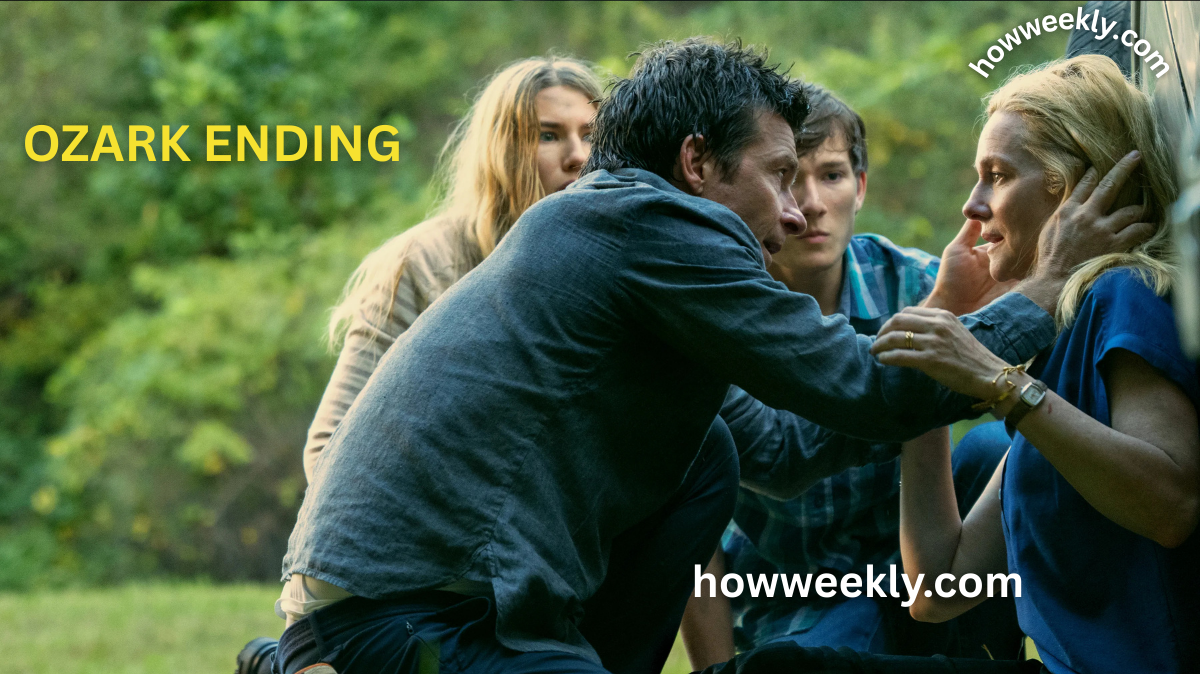Introduction: Saying Goodbye to Ozark Ending
If you’ve been following Marty and Wendy Byrde’s harrowing journey through four intense seasons of money laundering, cartel drama, and impossible choices, the Ozark ending likely left you speechless—or at the very least, deep in thought. Created by Bill Dubuque and Mark Williams, Ozark has been one of Netflix’s most compelling crime dramas, with Jason Bateman and Laura Linney delivering powerhouse performances. The show’s slow-burn intensity and moral ambiguity kept fans glued to their screens, especially in its climactic fourth season. But what does the Ozark ending really mean? And more importantly, how should we feel about that ending?
In this article, we’re going to break down the Ozark ending in all its complexity. From character arcs and narrative symbolism to the moral questions the show ultimately raises, we’ll explore every major facet of the finale. So whether you loved it, hated it, or are still trying to wrap your head around it, let’s dig into what really went down in the final chapter of Ozark.
Marty and Wendy Byrde: Architects of Their Fate in the Ozark Ending
Let’s start with the two central figures of the show—Marty and Wendy Byrde. Throughout Ozark, these two have navigated increasingly murky moral waters. From their early attempts at survival in the Ozarks to their eventual transformation into ruthless power players, the Byrdes’ arc is a study in how power corrupts—and how people justify the means to achieve their ends.
In the Ozark ending, we see that Marty and Wendy essentially get everything they want: the casino deal goes through, their political ambitions take root, and they manage to eliminate most threats to their empire. Yet, the tone is far from triumphant. Instead of a typical Hollywood ending where the antiheroes get punished or redeemed, the Ozark ending gives us something far more unsettling—Marty and Wendy win, but at a massive cost to their souls.
Their son Jonah’s final act—pulling the trigger on Mel Sattem—cements the family’s moral collapse. Even the kids are now embroiled in this web of deceit and violence. It’s a chilling reminder that in the Byrdes’ world, survival means compromising your ethics, and eventually, those compromises become your identity.
Wendy, in particular, has one of the most striking arcs. From a supportive wife and political consultant to a power-hungry matriarch willing to sacrifice nearly anything for control, her transformation is both fascinating and terrifying. Some fans argue she became the true villain of the series, but that label oversimplifies her character. Wendy’s actions are born out of desperation, ambition, and a warped sense of protection for her family. That complexity is what makes her so compelling.
Marty, meanwhile, remains the show’s quiet force—calculating, pragmatic, and often morally conflicted. He doesn’t enjoy the violence or manipulation, but he enables it nonetheless. By the Ozark ending, his silence speaks volumes. He no longer protests Wendy’s choices; he simply helps her carry them out. And that complicity is his final descent.
Ruth Langmore: A Tragic Heroine in the Ozark Ending
Ruth Langmore’s journey throughout Ozark is arguably the emotional core of the series. From her rough beginnings as a tough-talking trailer park girl to her emergence as a shrewd businesswoman and deeply wounded soul, Ruth is the character most viewers rooted for. She represented the possibility of redemption and change in a world that seemed designed to crush people like her.
So when Ruth is killed in the Ozark ending by Camila Elizonndro, it hits like a gut punch. Her death is not just tragic—it feels deeply unjust. After everything she survived—the betrayal of her family, the murder of her father, the manipulation by the Byrdes—Ruth’s attempt at building a better life ends with her lying in the dirt. It’s a brutal reminder of Ozark’s central theme: in this world, the good rarely win.
Some viewers were outraged by Ruth’s death, seeing it as a betrayal of the show’s emotional heart. But from a storytelling perspective, it’s tragically consistent. Ruth was always too principled, too unwilling to become fully corrupt. That refusal to bend is what makes her admirable—and what ultimately dooms her.
Her death also serves as a narrative mirror to the Byrdes’ success. While they ascend, Ruth pays the price for trying to escape the cycle of crime and poverty. It’s a cruel irony, and one that underscores the show’s bleak worldview. In the Ozark ending, Ruth remains true to herself, which in Ozark means she can’t survive.
:max_bytes(150000):strip_icc()/OZARK_402_Unit_00159R-f25f4fc0c5a5404c894ca533a52a9fae.jpg)
Yet even in death, Ruth leaves a legacy. Her presence haunts the final scenes, a ghostly reminder of what was lost. She may not have won, but she never lost who she was—and that, in a show like Ozark, might be the closest thing to a victory.
Jonah Byrde and the Final Shot in the Ozark Ending
The last moment of Ozark is one of its most talked-about scenes. Jonah Byrde, the once-naive youngest member of the Byrde clan, points a shotgun at Mel Sattem, the persistent private investigator who’s finally uncovered proof of the Byrdes’ crimes. The camera cuts to black just as we hear a gunshot.
It’s an unmistakable callback to The Sopranos and its famously ambiguous ending, and it serves a similar purpose. The audience is left to interpret what happened—and what it means. But in this case, the symbolism is slightly clearer. Jonah has crossed a line. Whether or not we actually see the bullet hit its target, the implication is that he has become a full participant in the family’s moral descent.
Jonah’s journey is heartbreaking in its own way. He starts as a precocious, intelligent kid with a sense of right and wrong. As the show progresses, he rebels against his parents, horrified by their choices. But by the Ozark ending, that rebellion gives way to resignation. Jonah realizes that in order to protect his family, he must become like them.
The final shot (pun intended) cements this transformation. It’s not just the end of the series—it’s the end of Jonah’s innocence. He has become what his parents molded him into: someone who can rationalize murder for the sake of family and power. That the Ozark ending closes here is no accident. It’s the final, bleak note in a symphony of moral decay.
Of course, there’s also a practical narrative reason for the scene. Mel Sattem had to be eliminated to ensure the Byrdes’ continued safety. But the decision to have Jonah be the one to pull the trigger adds emotional weight. It’s the show’s way of saying: this cycle will continue, and now a new generation is carrying the torch.
Camila Elizonndro and the Real Power in the Ozark Ending
While the Byrdes have been the focal point of Ozark, the final season introduces a powerful new player in Camila Elizonndro, sister to Omar Navarro and eventual head of the Navarro cartel. Camila is a different kind of threat—quiet, composed, and ruthlessly efficient. Where others in the cartel made mistakes by being loud or impulsive, Camila bides her time, watches carefully, and strikes only when she’s certain.
Camila’s rise to power is one of the most interesting subplots of the final season. While Omar Navarro was constantly trying to balance brutality with diplomacy, Camila has no such illusions. She’s decisive and emotionally detached, traits that make her the perfect crime boss in the Ozark universe. Her murder of Ruth is swift, cold, and calculated—not personal, but necessary.
What makes Camila such a chilling figure is how easily she manipulates those around her. She’s always three steps ahead, and unlike many of the male cartel members we’ve seen, she doesn’t let ego get in the way. Her character reflects a shift in the show’s power dynamics, illustrating that control doesn’t always come from brute force—it can also come from cunning and patience.
In many ways, Camila represents the final test for the Byrdes. She’s the ultimate expression of the world they’ve chosen to inhabit. In negotiating with her and ultimately surviving her wrath, Marty and Wendy prove they’re not just survivors—they’re winners. But again, it’s a hollow victory. They’ve had to abandon their morals completely, and now they must coexist with someone like Camila, who represents the monster they were trying not to become.
And in this world, that’s what success looks like.
Thematic Legacy of Power, Corruption, and Family in the Ozark Ending
Now that we’ve unpacked the key players and moments of the Ozark ending, let’s talk about the broader themes that make Ozark such a compelling show. At its core, Ozark is a story about power—who has it, who wants it, and what people are willing to do to keep it. But it’s also about the corrosion of values, the slow chipping away of what makes us human.
The Byrdes’ journey is a cautionary tale. They start with good intentions—or at least understandable ones. Marty gets into money laundering to protect his family. Wendy joins in because she wants a better life. But every step they take down that road requires another compromise, another lie, another body. By the Ozark ending, they’re unrecognizable from who they were in season one.
Yet the show never offers easy answers. There’s no moment of catharsis or redemption, no final judgment passed down from above. Instead, Ozark challenges the viewer to reckon with the uncomfortable truth: sometimes the bad guys win. And sometimes, those bad guys look a lot like us.
Family is another central theme, and in Ozark, it’s both a motivation and a justification. Every horrific act the Byrdes commit is done in the name of protecting their children. But in doing so, they end up destroying the very thing they were trying to save. The family survives, yes—but at what cost?
The show’s bleakness isn’t just for shock value. It’s a reflection of a world where morality is fluid, where institutions are corrupt, and where the line between good and evil isn’t just blurred—it’s obliterated. And in that sense, Ozark is one of the most honest portrayals of crime and consequence in modern television.




